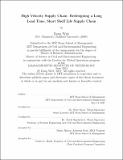High Velocity Supply Chain: Redesigning a Long Lead Time, Short Shelf Life Supply Chain
Author(s)
Witt, Doug
DownloadThesis PDF (6.684Mb)
Advisor
Spear, Steve
Simchi-Levi, David
Terms of use
Metadata
Show full item recordAbstract
Composite materials, which can be simultaneously lighter and stronger than aluminum, provide multiple advantages to the aerospace industry. However, the heat-sensitive resins used in these materials begin degrading as soon as they are manufactured. As a result, providers of composite raw materials manufacture all their goods on a make-to-order basis. In turn, long lead times are passed on to OEM customers,
such as Bell. Bell must manage an inbound supply chain with worst case parameters: expensive, cold chain material with long lead times and short shelf lives. Historically, Bell has scrapped over $ 1M/year of these products due to expiration, and meanwhile, multiple stockout events every year adversely impact production schedules.
This project addresses these problems by imagining inventory as a control loop problem, where we take the system from its current form as an "open" loop and convert it to a self-correcting "closed" loop. We do this by first specifying an exact setpoint level: in our case, a base stock policy. We then improve the difference between specified level and actual level by improving our forecasting technique using three-month moving averages and information already contained within the Manufacturing Resource Planning (MRP) system. We make the system more responsive by making deliveries as frequent as possible. We find this model simultaneously reduces stockout risk, expiration risk, inventory levels, and lead time apparent to Bell. We make this
assessment using both historical and simulation data.
Finally, this line of thinking spurs us to reexamine an old problem in supply chain theory: that of optimum lot size. We find using a Monte Carlo model that increasing lot size (or order minimums) beyond what is required during a review period increases stockout risk.
Date issued
2021-06Department
Sloan School of Management; Massachusetts Institute of Technology. Department of Civil and Environmental EngineeringPublisher
Massachusetts Institute of Technology